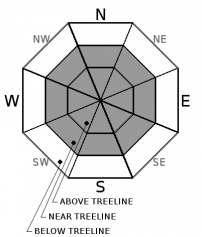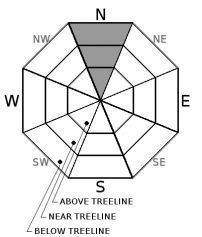| Monday | Monday Night | Tuesday | |
|---|---|---|---|
| Weather: | Mostly cloudy with a chance of snow | Mostly cloudy becoming partly cloudy | Partly cloudy becoming sunny |
| Temperatures: | 28 to 33 deg. F. | 16 to 21 deg. F. | 28 to 33 deg. F. |
| Mid Slope Winds: | West shifting to northwest in the afternoon | North | East |
| Wind Speed: | 20 to 30 mph with gusts to 55 mph decreasing to 10 to 15 mph with gusts to 30 mph in the afternoon | 10 to 15 mph with gusts to 35 mph | 10 to 20 mph with gusts to 35 mph |
| Expected snowfall: | up to 1 | 0 | 0 |
| Monday | Monday Night | Tuesday | |
|---|---|---|---|
| Weather: | Mostly cloudy with a chance of snow | Mostly cloudy becoming partly cloudy | Partly cloudy becoming sunny |
| Temperatures: | 24 to 29 deg. F. | 16 to 21 deg. F. | 29 to 34 deg. F. |
| Ridge Top Winds: | West shifting to northwest in the afternoon | Northeast | Northeast |
| Wind Speed: | 35 to 55 mph with gusts to 100 mph decreasing to 15 to 25 mph with gusts to 55 mph in the afternoon | 20 to 40 mph with gusts to 55 mph increasing to 75 mph after midnight | 20 to 40 mph with gusts to 95 mph decreasing to 70 mph in the afternoon |
| Expected snowfall: | up to 1 | 0 | 0 |

























